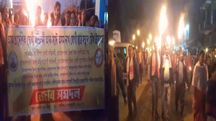
How Pallabi Ghosh from Assam's Lumding rescued over 10,000 girls from human traffickers
Pallabi Ghosh from Assam has emerged as a key figure in combating human trafficking in India with her constant efforts leading to the rescue of over 10,000 girls.

Pallabi Ghosh, hailing from Lumding, a railway town in Assam, stands as a formidable figure in the battle against societal injustices in India. From rescuing over 10,000 girls from traffickers to saving a 4-month-old from getting sold to the Middle East by the mother herself, the story narrated by Pallabi Ghosh is truly daunting.
Her journey began at the age of 12 when she witnessed her first case during a visit to a village in West Bengal 21 years back . There, she encountered a father desperately searching for his missing daughter. As a 12-year-old she felt dejected by the incident and took notes of the missing child along with the helpless father.
Over the years, Pallabi encountered numerous cases of women disappearing from states like West Bengal, Odisha, Assam, Jharkhand, Chattisgarh, Andhra Pradesh, Tripura, Bihar to name a few, only to reappear in distant states like Haryana and Rajasthan, and many other states often wedded to men twice their age as there was skewed sex ratio. This ongoing research led her to the grim reality of trafficking, where vulnerable women fall prey far too easily.

Driven by these traumatic encounters, Pallabi immersed herself in the field, along with police team and NGOs initially as a staff and then a consultant visiting police stations sharing the cases, conducting recce and then accompanying law enforcement to do raids, in 12 years rescuing over 10,000 women, girls and children from all kinds trafficking with support and assistance police, social welfare departments and other stakeholders. The rescues were mostly made from brothels, bungalows, and factories, industries, brick kilns
to name a few, where they were forced into marriage, bride trafficking, prostitution, child marriage, debt bondage, modern slavery, etc.
Working as an activist since 2012, Pallabi had to quit terms with various organizations that worked under, after she realised that they focused solely on rescue operations without addressing the critical need for rehabilitation and empowerment . She firmly believed that rescuing girls was only helpful if followed by comprehensive rehabilitation efforts. This belief of hers was strengthened when she encountered several rescued girls who, due to lack of support, and assistance had tragically returned to the red-light areas.
The horrifying incident that led to the establishment of Impact and Dialogue Foundation:
March 2020, Pallabi Ghosh went on a rescue mission in North India, where she encountered distraught parents reporting their children had tested positive for COVID-19. During this time she observed that there was a lot of commotion among people because their children were infected by the virus. Even on the next day, more children were admitted. It came as a shock to Pallabi when she got to know that most children had passed away. She suspected some sort of foul play as it was just the first wave of COVID-19 and it was not possible for so many children to die. It was then that she decided to dig out from whichever resources she could and found out that the children were declared dead and their organs were taken out.
Deeply shaken, Pallabi immediately sought assistance from various organizations and NGOs, who advised her to gather evidence. Despite her relentless efforts to locate witnesses, she found none willing to come forward. Families had disappeared without a trace, leaving Pallabi feeling disheartened and helpless by the lack of support.
Struggling with trauma from the incident, Pallabi took decisive action by establishing the Impact and Dialogue Foundation as a charitable trust in Delhi. Over the next two years, she conducted extensive door-to-door outreach across West Bengal, Assam, Meghalaya, Uttar Pradesh, Delhi, Haryana, Rajasthan, Karnataka and Bihar. Her grassroots efforts aimed to uncover the root causes of trafficking.

The pattern in which the trafficking racket works:
Pallabi Ghosh recounted a harrowing tale of a trafficking survivor, illustrating the pattern of a trafficking network. The victim initially received a call from an unknown number, which she ignored at first. Subsequently, she began talking with the person who turned out to be a young man (Person 1) over calls and developed an emotional connection with him. They planned to elope, and he instructed her to meet him at the railway station.
Upon arriving at the station, she encountered a different man (Person 2), disguised as Person 1's friend. As she waited with Person 2, he left momentarily to fetch water, during which another man (Person 3) approached and assisted her in finding her train seat. Once settled, she fell asleep and awoke to find herself accompanied by yet another man (Person 4) who guided her to the Delhi railway station.
At Delhi station, she was met by another man (Person 5) who helped her find a rickshaw. Upon reaching her destination, she encountered another man (Person 6) who assisted her further. Finally arriving home, she was greeted by another man (Person 7). The following day, a different man (Person 8) accompanied her to a brothel, where she was then handed over to another man (Person 9) for exploitation.
Throughout her ordeal, the victim remained in a state of intoxication, making it difficult for her to fully comprehend the situation, though she could distinguish between the various men she encountered at each stage of her journey.
Reflecting on this case, Pallabi Ghosh asserted that these nine men were directly involved in trafficking, highlighting the complexity of such operations. However, she emphasized that determining the full extent of the trafficking network, including all associated individuals, remains a daunting challenge.

Root causes of trafficking in India:
During her surveys, Pallabi discovered that poverty, lack of education, vulnerability, and unemployment were significant contributors to such incidents. Recognizing the importance of community mobilization, she concluded that empowering communities to handle such crimes was crucial.
She began systematically mapping villages where male presence was sparse and families had no basic needs. Through her analysis, she discovered that trafficking often gripped households where men were absent or unemployed, leaving women as the primary breadwinners and vulnerable targets for exploitation.
Another significant factor Pallabi identified during her research was migration. She observed that rural residents, compelled by issues like unemployment, natural calamities, ethnic conflicts, health crises, better wages and water contamination, frequently migrated to urban areas where they became susceptible to trafficking.
During her extensive surveys, Pallabi uncovered harsh realities in rural India, where young girls were coerced into child marriages that often led to trafficking by their husbands.
Pallabi Ghosh emphasized that a major catalyst for trafficking was the lack of swift and decisive action against perpetrators. She stressed that without immediate conviction and stringent laws, traffickers continued to operate with impunity, perpetuating the cycle of exploitation.
She highlighted a procedural challenge in registering trafficking cases with the National Bureau of Records. Victims or their advocates must first file a First Information Report (FIR), typically categorized as a missing person or elopement case. Only after victims declare themselves as trafficked can they navigate a procedural correction under Article 368 of the constitution, which is necessary for the case to be officially registered as one of trafficking.
What are the obstacles that prevent the registration of trafficking cases:
Pallabi Ghosh highlights significant obstacles in registering trafficking cases, noting that societal perceptions vary starkly between cases of child marriage, where blame often falls on families, and human trafficking, which tarnishes the country's reputation internationally.
She further points out the challenges of gathering evidence in human trafficking cases, which severely impedes reporting. Additionally, she underscores the absence of legislation providing adequate protection to witnesses, compounding the difficulty of prosecuting traffickers.
Cases that do reach the courts face prolonged delays spanning years, prolonging the victim's trauma through repeated procedural requirements. Pallabi advocates for the establishment of fast-track courts dedicated to expediting such cases and delivering timely justice.
Pallabi also critiques societal attitudes, noting instances where victims of trafficking are ostracized upon disclosing their ordeal. This stigma, she argues, contributes to underreporting and hinders victims from seeking justice.
She further elucidates on the deceptive tactics employed by traffickers, who lure victims under false pretenses such as promises of love, marriage, job opportunities, or simple outings like movies, shopping, or dining. These methods exploit vulnerabilities and deceive victims into perilous situations.
Now with the advent of Bharatiya Nyaya Sanhita (BNS): Section 99, whoever buys, hires, or otherwise obtains possession of any child with intent that such child shall at any age be employed or used for the purpose of prostitution or illicit intercourse with any person or for any unlawful and immoral purpose, or knowing it to be likely that such child will at any age be employed or used for any such purpose, shall be punished with imprisonment of either description for a term which shall not be less than seven years but which may extend to fourteen years, and shall also be liable to fine.
Copyright©2026 Living Media India Limited. For reprint rights: Syndications Today









